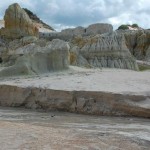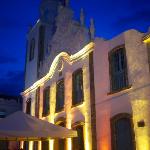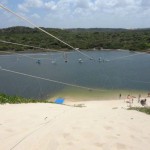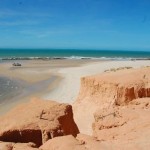[gn_spoiler title=”Dunes and beach of Genipabu” open=”0″ style=”2″]
Genipabu is internationally famous for its natural beauty, dunes, buggy and dromedary rides. The waters of the beach are warm, calm and clean, providing excellent sea bathing for all the family. Farther away, you can also enjoy surf and jet skiing. From buggy you can also visit a pond, with activities such as bathing in fresh water, paddle boats and kayaks.
Dunes Park
If you want to visit the Dunes Park, the Namorados Forest is the entrance gate. It has approximately 7 hectares with 1,300 trees representing 50 native species of the rainforest, where there are environmental education activities, scientific research and ecotourism.
There are three trails in the Dunes Park, two of them cross the park from west to east, leaving from the Namorados Forest reaching a lookout on Coastal Highway, and the third is intended for children and sedentary adults, passing through a short stretch and returning to the Namorados forest.
Visitors must pay a conservation fee of R$ 1.00 at the entrance of the park and R$ 1.00 at the reception of the trail in the Namorados Forest.
- Parque Estadual Dunas de Natal – Bosque dos Namorados
- Av.Alexandrino de Alencar, S/ n, Tirol – 59015-350
- Phone:(84)201-3985/4440 Fax:(84)201-5353
- E-mail: parquedasdunas@digi.com.br
[/gn_spoiler] [gn_spoiler title=”Barra de Cunhau Beach” open=”0″ style=”2″]
The first impression of this beach is that it’s in front of a huge freshwater lake, instead of the Atlantic Ocean. Located in the municipality of Canguaretama, Barra Cunhaú has beautiful landscapes with palm trees, rivers and limpid green water. On the beach, the reefs form natural pools for swimming, making it a perfect place to relax. This environment also hosts a rich life of mangroves and shrimp farms.
[/gn_spoiler]
[gn_spoiler title=”Barra de Tabatinga” open=”0″ style=”2″]Large beach with big dunes and pebbles in the sand. When the tide is high you can see some dolphins swimming close to shore.
[/gn_spoiler]
[gn_spoiler title=”Lake Jacuma” open=”0″ style=”2″]Beautiful small lagoon, paradise situated amid the dunes of Jacumã.
The tourist who comes to visit this lake will reach the summit of the dune with a buggy and will practice the ‘Aero bunda’ type of zip lane suspended by a cable ending in the lake. Pure pleasure.
[/gn_spoiler] [gn_spoiler title=”Parrachos de Maracaju” open=”0″ style=”2″]Located 60 km from Natal, the Parrachos Maracajaú (coral reefs 7km far from the beach with floating bar structure) occupies an area of 13 km, excellent for snorkeling and diving, with coral underwater rising to the surface at low tide. It is one of the places in Brazil where the sea is the most crystalline and suitable for diving.
[/gn_spoiler] [gn_spoiler title=”Forte dos Reis Magos” open=”0″ style=”2″]Listed by national heritage, the Fort of Reis Magos is the most important monument of the city built in 1598. It was dominated by the Dutch from 1630 to 1654 was when it was taken over by the Portuguese. Besides this episode, the fort had strong others historical presence, for example, the fort was used as a prison by the Portuguese to confine whoever was fighting to the Independence, and then it was used by the Brazilians to confine the rebels Portuguese.
Its format resembles a star of 5 points. It has a chapel with well, accommodations and old cannons. It offers guided tours.
Located at Praia Forte – Natal
[/gn_spoiler] [gn_spoiler title=”Natal Aquarium” open=”0″ style=”2″]The aquarium has 29 tanks with nearly 60 marine species.
Av. Litorânea, 1091, Redinha – Extremoz – RN, 59575-000
[/gn_spoiler] [gn_spoiler title=”Church Santo Antonio” open=”0″ style=”2″]Buit in 1766, the Santo Antonio Church is one of the most important works of the city. Baroque-style church is known as the Rooster church, since there is a metal rooster on top. The church houses the Museum of Sacred Art open to visitations
- Rua Santo Antônio, 683 – Cidade Alta – Natal / RN
- Phone(s) +55 (84) 211-4236
- Open Monday to Friday 9:00 am–5:00 pm
Former Brazilian Institute of Forest Development-IBDF, which later became the IBAMA, created the Tamar Project in 1980 the Brazilian Institute of the Environment. Today, it is recognized internationally as one of the most successful experiences of marine conservation and serves as a model for other countries, especially because it involves coastal communities directly in socio-environmental work.
Located on the southern coast of Rio Grande do Norte on the Pipa beach, the Tamar project is engaged in the research, conservation and management of five species of endangered sea turtles. In the spawning season, between September and March, the foundation monitors 33km of beaches, protecting more than 1,600 nests annually and 100,000 chicks.
[/gn_spoiler] [gn_spoiler title=”Praia Quixaba Beach” open=”0″ style=”2″]Located 158 km from Fortaleza city and 3 km from Canoa Quebrada beach, its natural beauty served as backdrop for several national films. The beach of Quixaba with its beautiful white and red sandy cliffs is visited by families and is a good destination for those looking for tranquility and beautiful scenery.
Being a fishing village it is a perfect place to find the best shrimp and fresh fish from the region with the best prices.
Quixaba has no sophisticated hotels and restaurants, except for the restaurant attached to the Pousada Dona Lucia, where besides good fish, you can eat a wonderful duck. The best tents on the beach are the Chaguinha and Velho Marujo (Old Sailor).
Just 155 km east of Fortaleza, Canoa Quebrada has a stable climate between 27 º C and 30 º C (80º F to 86º F) throughout the year and beaches with magnificent palm trees, cliffs and lagoons between huge sand dunes.
The winds from the east up to 30 knots with calm waters are perfect for practicing and learning kitesurfing and for a catamaran trip. For the adventurous it has buggy and ATV’s rides, horseback riding and, if you want to get a bit of Brazilian culture, you can take capoeira classes.
A Broadway street (main street of Canoa Quebrada) is point and address of the majority of bars, nightclubs and restaurants in the village, where you can enjoy the regional cuisine and the famous “house trio”, a dish with lobster, shrimp and fish, big enough for three people.



